
Caution tape blocks an entrance to the beach as Palm Beach County officials closed all county beaches due to red tide affecting coastal areas in October 2018 in Lake Worth, Florida. However, when the algae - which produces a neurotoxin, called brevetoxin - washes up and grows on the coastline at higher levels, it causes major environmental, economic, and health damage.

Karenia brevis is present in Florida waters year-round, but it usually exists at such low levels that it has no effect on marine life or people, said Michael Crosby, the president and CEO of Mote Marine Laboratory and Aquarium, an independent research institution in Sarasota. The bloom, which began in October, is now found across the southwest coast of the state. Last month, right when spring break travel was set to heat up, harmful levels of the algae were found across Pinellas County, home to the city of Clearwater, leading to the cancellation of festivals and sweeping beach clean-ups. Nearly every fall, the crystal clear waters of the Gulf Coast turn red due to high quantities of Karenia brevis, a type of harmful algal bloom. But a biological phenomenon known as red tide is putting spring break revenue and the health of locals and revelers alike at risk. These travelers bring in vital revenue for the Sunshine State, with one county alone, Pinellas County, raking in $13 million in tax revenue in March last year. CDFW and aquarium staff were able to drive her away from the area, but she returned to her stomping grounds and resumed her unusual behavior last month.This year, as in many past, millions have flocked to Florida’s Gulf Coast for spring break vacations. Like her current summer escapades, otter 841 was caught harassing surfers in Santa Cruz last September. Officials want to catch the otter so she can be thoroughly examined at the Monterey Bay Aquarium before finding her a new home, all but certainly in an approved zoo or aquarium. The CDFW says the otter could be behaving this way because of positive interactions with people, such as feeding, which would explain why she's not exhibiting a healthy fear of humans. She was successfully released into the wild in June 2020 and appeared to be doing well, until last September, when her interactions with humans were first documented in the area. Monterey Bay Aquarium spokesperson Kevin Connor previously told NPR that otter 841 was born in the aquarium approximately five years ago, where she was raised by her mother and minimally cared for by staff disguised in black rubber suits and welding masks to hide their human appearance. Wildlife experts remain uncertain about why the otter is behaving this way. The California Department of Fish and Wildlife (CDFW) told NPR that capture efforts could be "suspended or halted entirely" if the otter continues to elude officials and stops interacting with people. Biologists say catching the otter could take days or weeks because of environmental conditions like water clarity. However, the agencies charged with catching 841 have maintained their stance that capturing and rehoming her is best for the otter and humans alike. Scientists want to bring her to the Monterey Bay Aquarium for an evaluation before rehoming her to a zoo or aquarium.

There are several petitions circulating online in support of 841's freedom, one of which has gathered over 50,000 signatures.Ĭalifornia Department of Fish and Wildlife Inclement weather has proven advantageous for Otter 841, which has evaded capture for over a week. "I don't have all the facts and history of the incidents but it just seems to me to be yet another example of humans feeling that they have the right of way on the earth and that other contemporary species and their rights to their native habitats are expendable," Stadler wrote. Last week, he snapped a photo of an activist dressed as an otter holding a surfboard that read "Keep 841 free." Another local, Ann Stadler, voiced her support for otter 841 in a letter to the editor in the Santa Cruz Sentinel published on Thursday. Mark Woodward is a local Santa Cruz photographer who has chronicled 841's adventures for over a month on Instagram. But support for a live-and-let-live approach is growing with each unsuccessful attempt. As a result, wildlife officials and Monterey Bay Aquarium staff are attempting to capture and rehome the otter to an aquarium or zoo, according to a joint news release. The 5-year-old female otter, known officially as otter 841, has been deemed a public safety risk by state and federal wildlife officials because of her "unusually aggressive" behavior along the Santa Cruz coast. But its outlaw status has turned the slippery sea otter into an international icon, with growing support to leave her in the wild. An otter in California is on the run from local and federal authorities, wanted for aggressively confronting locals and stealing surfboards at a popular beach.


 0 kommentar(er)
0 kommentar(er)
